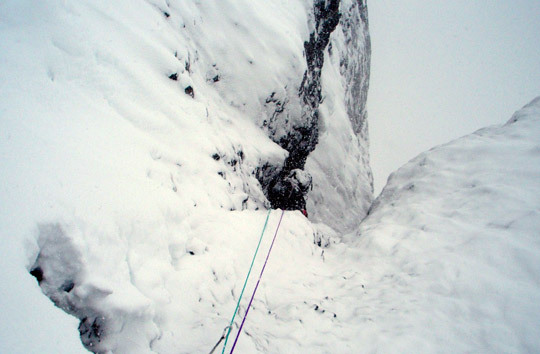
The northeast face of Mt. Chephren (3307m) from the Icefields Parkway, Alberta, Canadian Rockies. The Dogleg Couloir (V/VI M7 A1, ca. 1300m), a new route climbed by Raphael Slawinski and Pierre Darbellay March 22-24, takes the red line. Two weeks before, Slawinski completed the first winter ascent of the Greenwood-Jones (IV/V M6, 1300m) on Mt. Temple (3543m) over three days; Steve House and Roger Strong made its second winter ascent on March 20 in a 25.5 hour push. [Photo] Raphael Slawinski
Fewer than two weeks after Alpinist Correspondent Raphael Slawinski made the first winter ascent of the Greenwood-Jones (IV/V M6, ca. 20 pitches, 1300m) on Alberta’s Mt. Temple with Eamonn Walsh and Ian Welsted (read the March 14, 2008 NewsWire for more information), Steve House and Roger Strong repeated the line in a single 25.5-hour push on March 20. Two days later Slawinski was at it again, this time with Swiss guide Pierre Darbellay, establishing The Dogleg Couloir (V/VI M7 A1, ca. 1300m) on Mt. Chephren (3307m), also in Banff National Park.
In summer the Greenwood-Jones is a long 5.9 Canadian Rockies classic that is relatively accessible from the road; it was the last major route on the north face of Mt. Temple (3543m) to receive a winter ascent. Inspired by Slawinski, Walsh and Welsted’s recent three-day redpoint, and getting rave reviews about the line and the conditions from them, House and Strong decided–after a couple beers–that they would attempt the Greenwood-Jones in a single push. “Knowing how strong and humble Raph and Eamonn are, we were a bit intimidated, but Steve and I wanted to see if it could be done,” Strong said.
On March 20, House and Strong made the round-trip push from a camp at Lake Annette. They left the tent from Lake Annette at 5:45 a.m., began climbing at 6:40 and reached the ridge about midnight, summiting at 2 a.m. and descending via the very long southwest ridge. They returned to camp at 7:15 a.m.
Considering the notoriety of poor snowpack and bitterly cold winter weather in the Rockies, the pair had decent conditions: boilerplate snow and ice on the summit ridge and temperatures just below 0 degrees F during most of the climb. They reported that the climbing was varied and enjoyable–“good quality rock, chossy rock, hand jams, delicate feet, drytooling, gloved face moves, gloves freezing to the rock”–and that route finding was not always straightforward. While finishing the upper technical pitches in the dark, House took a lead fall after breaking a pick and trying to free climb with cold hands.
Slawinski considers the speedy ascent impressive: House and Strong were “pushing the boat out a bit further,” he said. They carried little gear, some food, water and a stove. Slawinski, Walsh and Welsted–“carrying all the comforts of home with us” but spreading out the ascent over three days–had spent about 28 hours actually climbing and descending the Greenwood-Jones.
From March 22-24, Slawinski and Pierre Darbellay went after a longer and more committing new line on the northeast face of Mt. Chephren. Climbing just right of Wild Thing (VI 5.9 WI4 A3, 1500m), they climbed the “long snow gully that became progressively harder, culminating with multiple pitches of snow-choked chimneys broken by steep snow ledges.” Expecting to free the route they were disappointed to resort to aid at four points on the last pitch when their exit options ran out and the weather deteriorated. After climbing for eighteen hours on the 23rd, they descended the easy south face, a walk up route in summer, in “winter post-hole hell.”
The Dogleg Couloir had been attempted, with varying degrees of commitment, by numerous others–Ken Wallator; Dana Ruddy; Sean Easton, Dave Marra and Cory Balano; Eamonn Walsh and Slawinski; Chris Brazeau and Jon Walsh–without success.

Darbellay topping out the third rock band of The Dogleg Couloir in bad weather on March 23. “Looks like one easy pitch to the top, eh?” It turned out to be three hard ones. [Photo] Raphael Slawinski